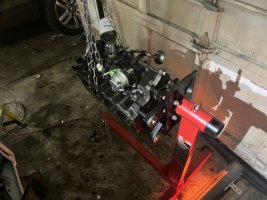For surface prep of both the head and block deck surfaces, clean them by hand only. Take your time and scrape them with a razor blade in a scraper. A large, fine, flat file would be ok for locating any high spots or imperfections by lightly dragging it across the surface.
The roloc abrasive discs will clean the surfaces up quickly but I would shy away from using them here, they can remove material very quickly. if your local mechanic/machinist checked it and ok'd the flatness, clean up by hand is all you need to do and eliminates the chance of creating low spots.
The roloc abrasive discs will clean the surfaces up quickly but I would shy away from using them here, they can remove material very quickly. if your local mechanic/machinist checked it and ok'd the flatness, clean up by hand is all you need to do and eliminates the chance of creating low spots.


